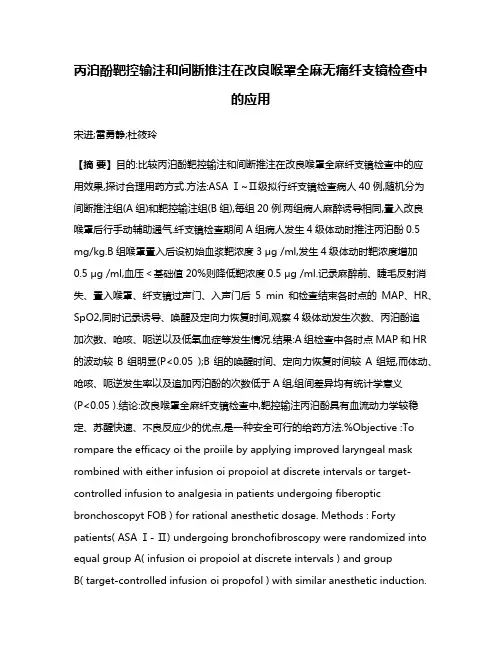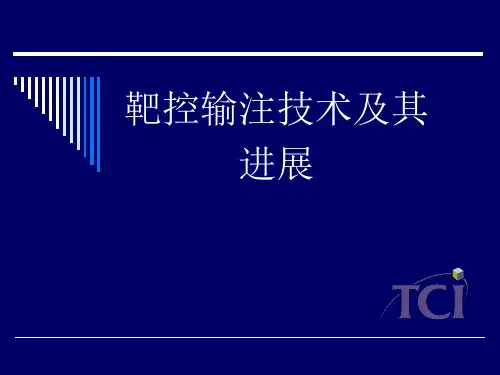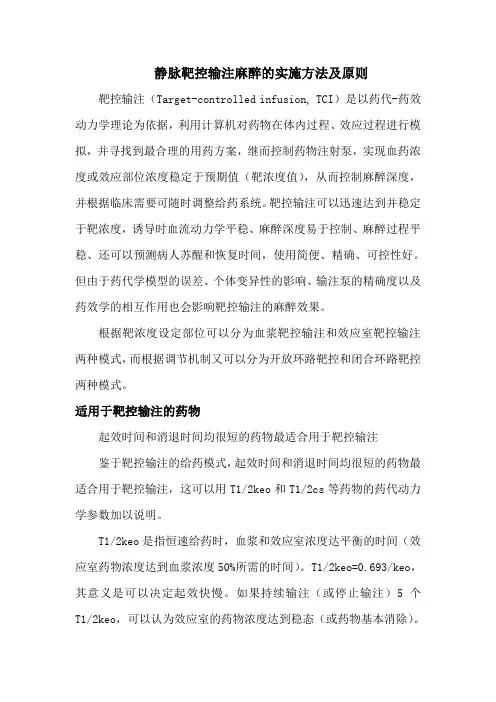靶控输注技巧及停顿[精品
- 格式:ppt
- 大小:2.53 MB
- 文档页数:47


丙泊酚靶控输注和间断推注在改良喉罩全麻无痛纤支镜检查中的应用宋进;雷勇静;杜筱玲【摘要】目的:比较丙泊酚靶控输注和间断推注在改良喉罩全麻纤支镜检查中的应用效果,探讨合理用药方式.方法:ASA Ⅰ~Ⅱ级拟行纤支镜检查病人40例,随机分为间断推注组(A组)和靶控输注组(B组),每组20例.两组病人麻醉诱导相同,置入改良喉罩后行手动辅助通气.纤支镜检查期间A组病人发生4级体动时推注丙泊酚0.5 mg/kg.B组喉罩置入后设初始血浆靶浓度3 μg /ml,发生4级体动时靶浓度增加0.5 μg /ml,血压<基础值20%则降低靶浓度0.5 μg /ml.记录麻醉前、睫毛反射消失、置入喉罩、纤支镜过声门、入声门后5 min和检查结束各时点的MAP、HR、SpO2,同时记录诱导、唤醒及定向力恢复时间,观察4级体动发生次数、丙泊酚追加次数、呛咳、呃逆以及低氧血症等发生情况.结果:A组检查中各时点MAP和HR 的波动较B组明显(P<0.05 );B组的唤醒时间、定向力恢复时间较A组短,而体动、呛咳、呃逆发生率以及追加丙泊酚的次数低于A组,组间差异均有统计学意义(P<0.05 ).结论:改良喉罩全麻纤支镜检查中,靶控输注丙泊酚具有血流动力学较稳定、苏醒快速、不良反应少的优点,是一种安全可行的给药方法.%Objective :To rompare the efficacy oi the proiile by applying improved laryngeal mask rombined with either infusion oi propoiol at discrete intervals or target-controlled infusion to analgesia in patients undergoing fiberoptic bronchoscopyt FOB ) for rational anesthetic dosage. Methods : Forty patients( ASA Ⅰ- Ⅱ) undergoing bronchofibroscopy were randomized into equal group A( infusion oi propoiol at discrete intervals ) and groupB( target-controlled infusion oi propofol ) with similar anesthetic induction.Manually assisted ventilation was carried out in the two groups at placement oi the improved laryngeal mask. Patients in group A were managed with infusion oi propoiol in dose oi 0. 5 mg/kg during the proce dure at body response by stage Ⅳ. In group B,the target plasma concentration oi propoiol was initially set at 3 μg/ml after successful placement oi the laryngeal mask and increased by 0. 5 μg /ml at body response by stage Ⅳ , whereas decreased by 0.5 μg /m l upon 20% fall of the basic value of blood pressure. Mean arterial pressure( MAP ),heart rate( HR ) and SpO2 were maintained at the time points of prior to anesthesia, loss of eyelash reflex,placement of laryngeal mask , bronchofibioscope through the vocal cords,live minutes after bronchofibioscope passage down the vocal cords and completion oi check-up. Records were also kept concerning the induction time, awakening from anesthesia, duration oi orientation force recover-y,frequencies oi body response at s tage Ⅳ, extra dosage oi propoiol and occurrences oi bucking, hiccupping and hypoxemia. Results: The fluctuation oi MAP and HR dining the procedure was more significant in group A compared to group B( P < 0. 05 ), whereas the group B had shorter time for awakening and recovery of the orientation force, lower incidences of body response, bucking and hiccoughing and less dose requirement oi additional propoiol. The two groups were statistically different ( P < 0. 05 ). Conclusion : Application oi improved laryngeal mask with target-controlled infusion oi propoiol to fiberoptic brohchoscopy may ensure stable hemodynamics and early awakening irom anesthesia, yetproduce less adverse eiiects, suggesting that this proiile is a safe recommendation in clinic.【期刊名称】《皖南医学院学报》【年(卷),期】2013(032)001【总页数】4页(P49-52)【关键词】喉罩;异丙酚;间断推注;靶控输注;纤维支气管镜检查【作者】宋进;雷勇静;杜筱玲【作者单位】芜湖市第二人民医院,麻醉科,安徽,芜湖,241000【正文语种】中文【中图分类】R614.2纤维支气管镜检查术是呼吸道疾病诊断和治疗的重要手段之一[1],传统的纤维支气管镜检查方式是在咽部作局部喷雾表面麻醉,患者在清醒状态下接受检查,易出现生理、心理不适,影响检查质量,多数受检者不愿意接受再检查[2]。









静脉靶控输注麻醉的实施方法及原则靶控输注(Target-controlled infusion, TCI)是以药代-药效动力学理论为依据,利用计算机对药物在体内过程、效应过程进行模拟,并寻找到最合理的用药方案,继而控制药物注射泵,实现血药浓度或效应部位浓度稳定于预期值(靶浓度值),从而控制麻醉深度,并根据临床需要可随时调整给药系统。
靶控输注可以迅速达到并稳定于靶浓度,诱导时血流动力学平稳、麻醉深度易于控制、麻醉过程平稳、还可以预测病人苏醒和恢复时间,使用简便、精确、可控性好。
但由于药代学模型的误差、个体变异性的影响、输注泵的精确度以及药效学的相互作用也会影响靶控输注的麻醉效果。
根据靶浓度设定部位可以分为血浆靶控输注和效应室靶控输注两种模式,而根据调节机制又可以分为开放环路靶控和闭合环路靶控两种模式。
适用于靶控输注的药物起效时间和消退时间均很短的药物最适合用于靶控输注鉴于靶控输注的给药模式,起效时间和消退时间均很短的药物最适合用于靶控输注,这可以用T1/2keo和T1/2cs等药物的药代动力学参数加以说明。
T1/2keo是指恒速给药时,血浆和效应室浓度达平衡的时间(效应室药物浓度达到血浆浓度50%所需的时间)。
T1/2keo=0.693/keo,其意义是可以决定起效快慢。
如果持续输注(或停止输注)5个T1/2keo,可以认为效应室的药物浓度达到稳态(或药物基本消除)。
时量相关半衰期(context-sensitive half-time, T1/2cs)是指维持某恒定血药浓度一定时间(血药浓度达稳态后)停止输注后,血药浓度(作用部位药物浓度)下降50%所需的时间。
它不是定值,而是随输注剂量、时间的变化而变化。
其意义是可以预测停药后的血药浓度。
采用这两个参数较短的药物才能达到诱导、恢复都十分迅速的目的,又利于在麻醉过程中根据需要迅速调节麻醉深度,真正体现出靶控输注的特点。
目前临床使用的麻醉药物中,以瑞芬太尼(Remifentanil)和异丙酚(propofol)的药代动力学特性最为适合。